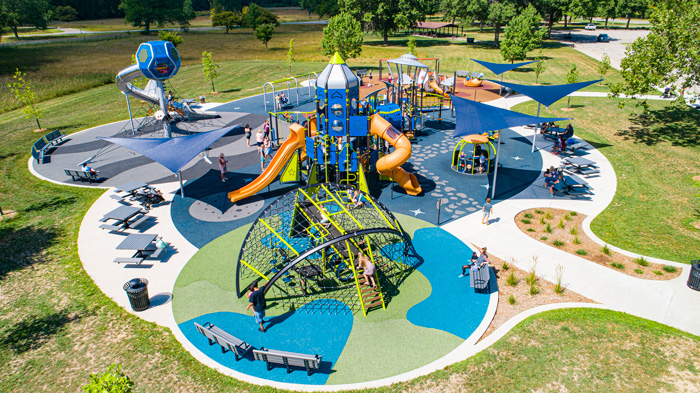The playground at my grade school was pretty bare bones. In my memory, it is more than 90% metal. Metal bars connecting to metal bars, with metal slides, and metal climbers. The exceptions were the seats on the swings (rubber, maybe?) and the seesaw (wood). It got us moving, and I spent plenty of time swinging (having learned to avoid the torturous sudden descent of the teeter-totter), but most of my recess time was spent in a more open area, away from the blacktop, where we could imagine ourselves lost in the wilderness.
At another grade school across town, which sometimes hosted summer league softball games where my older sister played, there was a slide shaped like a rocket ship. Oh, how all the kids loved that rocket ship. It sparked our imaginations and led to all kinds of fun and creative play.
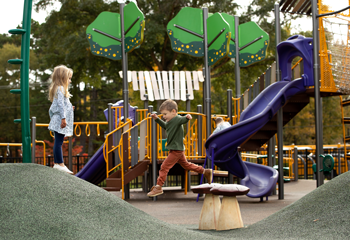
While kids can engage their imaginations to come up with all kinds of fun storylines to follow in their play, you can engage their excitement and stimulate their creativity by incorporating a theme as you plan, purchase and build out your playspace.
“A community might choose a themed playground to make the space more visually appealing, engaging, and to create a sense of place,” said Scott Roschi, creative director for a Delano, Minn.-based play equipment manufacturer. “A theme can also help to encourage imaginative play and support the overall educational and recreational goals of the playground environment. Additionally, adding a theme to the playground design can help make the play space more recognizable and memorable for the entire community.”
“A theme can give children a stimulating and engaging environment to play in,” said Avery Croteau, director of sales for a play equipment company with U.S. headquarters in Greenville, S.C. “It can also help to focus the design of the playground and its elements, so that it is more likely to appeal to children. Themes help to create an atmosphere of fun and imagination, encouraging children to explore and express themselves in a creative way.”
Themes are popular, according to Sarah Lisiecki, communications and education manager for a playground equipment manufacturer based in Fond du Lac, Wis., providing a way to tell a story and create a more imaginative experience. “Designing a custom-themed play environment is one way to engage children’s imaginations,” she said. “Kids will see imaginative opportunities anywhere. A tower can be, to a child, a castle, a rocket ship, a mountaintop or a racecourse. They develop their own play experiences, and it can be different every time. That’s the beauty of child-directed play—it’s their experience to define.
“Themed spaces are often destination spaces that will bring communities together for socialization, learning and fun,” Lisiecki added. “The replay experience is important here—kids need to find new and exciting ways to play each time they come to the space. Designing fresh, engaging and interesting play environments that are full of discovery and adventure guarantees kids will have a unique play experience each time they enter the space.”
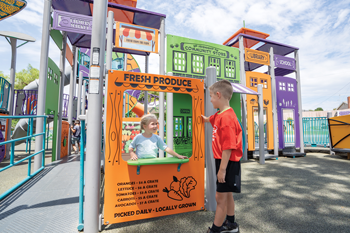
Given their appeal as destinations and imagination boosters, it’s no surprise to hear from President of the International Play Equipment Manufacturers Association, Brad Pittam, that themed playgrounds are taking off. “Not only are they fun and exciting to look at and have in your neighborhood, but they offer physical and mental stimulation to keep kids engaged and active in different ways.
“Offering themed playgrounds in communities allows for kids to use their imaginations in ways they may not on a day-to-day basis,” he added. “They can participate in the world that the themed playground offers, such as pretending they’re a prince or princess in a castle, or pirates on a pirate ship with an ocean-themed playground. These themes also aid social confidence—kids can come together and use their imaginations as a group, act out different scenes and work together as a team and bond as they connect to their surroundings.”
Pittam, who is also sales director, North America for a playground manufacturer with U.S. headquarters in Austin, Texas, added that educational themes can be beneficial for children and parents, too. “Parents can combine play and education together at the playground, and these education themes can present kids with new information that they can visualize in a fun, different way, which can lead to further interest in the topic and exposure to something they may not otherwise learn,” he said.
There’s a seemingly unlimited number of possibilities when it comes to playground themes, it can seem difficult to choose, but manufacturers do offer some guidelines for settling on an idea.
“There are so many ways to bring creativity to a themed space,” Lisiecki said. “Looking at the area around the space for ideas like farms, airports, water and woods can help inform what type of playspace might fit into the landscape. Others have a theme based on a child’s imagination or dream. Still others showcase the history of the area in which the space will exist. Themed playspaces attract a child’s attention and draw them in for play—and more play is always a good thing!”
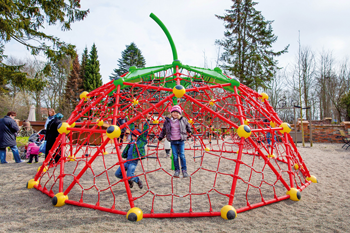
Croteau said you can let your fingers do the walking (or browsing, as the case may be), as there are ideas for creative playground themes all over the internet. “My best piece of advice is to choose a theme that is timeless,” he said. “It’s very easy to get consumed by what is popular today as opposed to what will be popular for the life of the playground. Nature, sea, space or locally significant elements will always be great themed spaces for kids to explore.”
Roschi said to explore ideas beyond the standard themes (farms, castles, spaceships), you should tap a crucial resource: local community members. “It’s important to assemble a team of community members who are passionate about the project, including parents, educators and local business owners, who can help guide and shape the ideas and connect it to the larger community,” he said. “Asking for ideas outside of more traditional themes encourages bigger conversations, which can lead to design ideas beyond the expected.”
Out-of-the-Box Solutions & Custom Themes
Special themes for playgrounds have been popular long enough that many play equipment manufacturers offer the opportunity to find a theme right off the catalog page. Other approaches—such as incorporating your town’s history or a geographic feature—might take a more custom approach. Either way, you’ve got plenty of possibilities to get your imagination humming.
“Many playground equipment manufacturers offer themed playstructures, including those based on popular characters, stories and settings,” Roschi said. “But digging into the local culture and history almost always leads to more personal, locally inspired themes for playground designs. And being able to tell a local story through play is a great way to educate children about their community, and remind adults about why they live in that community.”

“Inspiration can come from anywhere,” Lisiecki added, explaining that her company’s playground designers create exciting playspaces all the time. “Great ideas can get someone started down a path of imagination and inspiration, or can become exactly what they were searching for.”
Roschi offered another suggestion: keeping the theme abstract and letting kids decide what they want that space to be. This “… can encourage greater imaginative play as kids decide if it’s a castle or a fort or a spaceship,” he said. “Leaving more of the theme open, opens minds.”
He added, “Celebrating native plants and animals is a theme that is also becoming popular, which plays off of the desire to connect to and preserve the environment, but is still a little unexpected on the playground at this time.”
Another approach allows the space around the playground to help dictate the theme, Pittam said. “Incorporate the rocks, trees, grass areas and trails to your benefit when deciding and implementing a themed playground. Maybe the area is covered with different grassy nooks to create a hobbit theme from Lord of the Rings, or maybe the surrounding trees would be great for the rainforest theme or a treehouse theme. Using nature and the space around the playground is a great way to seamlessly integrate into the area.”
Croteau suggested using rope-based play equipment when you want to create a uniquely themed play space. “We recently finished a project using ropes to create an aviation theme,” he said. “The beauty is that the airplane we created was entirely a play unit. What I mean is that we didn’t build facades or themed accents, which most often are there purely for creating the theme. Using rope play, we were able to design a functional play solution that was completely playable. That’s the advantage of rope play—the rope is the play surface and a structural component.”
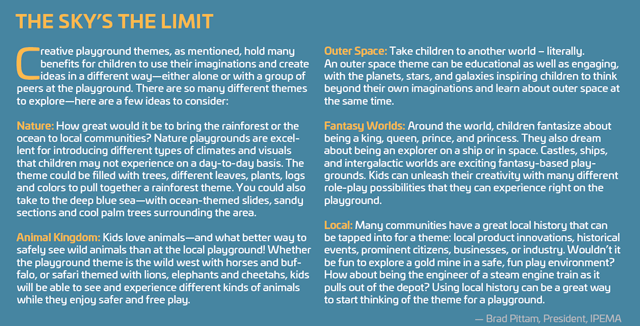
Before You Begin
If you’re planning a custom themed playground, you’ve got a big job ahead of you, but Pittam offered the following considerations to help set your playspace up for success as you work through the planning process:
- Consider the Area: What does the space look like? Do you have a single play area or multiple play spaces? What is the surface like? What is the surrounding area like? Is there room for parking lots? Sitting areas? Can the space include a universal design accommodating children and caregivers of all abilities? Is the area fit for ADA compliance and full inclusivity? Regardless of whether you’re building from the ground up or making an addition to an existing area, these are important questions during your initial planning phase.
- Consider the Budget: There are many aspects to consider when thinking about budget—is there funding or the potential for funding? There are different costs to consider: permits, preparing the site, equipment, surfacing, materials, installation, shipping, manpower and more. Making sure you know where your budget is coming from is extremely important—and will help determine how much you can or cannot do for the space.
- Out-of-the-Box and Custom Solutions: A theme may not add to your budget, as many IPEMA members have predesigned themed play pieces making for affordable options. On the flipside, when creating a theme, many IPEMA members can create a custom one-of-a-kind solution only limited by the imagination.
- Don’t Forget the Surface: Theming isn’t limited to the equipment. Amazing themes and a design can be created into the safety surfacing of the playground. Roads, train tracks, waves, swirls, flowers and other images can be created in a poured-in-place playground safety surface, for example.
- Consider the Timing: For most playgrounds, it takes time to plan and build, about nine to 12 months. Start with the time of year the playground should open—spring or summer is usually a great time for playgrounds to open—and work back from there.
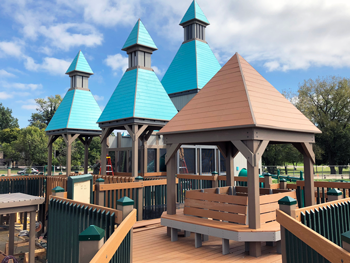
“Planning a playspace requires some general strategies and figuring out objectives so everyone can love and use the space for years to come,” Lisiecki added. “Creating project objectives and making certain all applicable standards are met will be important for any playground project. Themed spaces have added excitement and creativity, which requires a little more planning and making certain not only that the space looks amazing, but that it is usable, has play variety and brings loads of play value.”
Items to consider, Lisiecki suggested, include:
- Age range: What ages of children or adults will be using the space?
- Inclusivity: Creating a space that is both accessible and equitable means everyone will be able to find the best of themselves through play.
- Capacity: How many people do you need to play at once?
- Budget: How much can you spend?
- Space: How much room do you have to create this space and how can you best use it to meet your objectives?
- Play experience: What type of play experiences do you want users to have? How can you create a theme that engages kids and brings the community together?
- Location: Is the location easy to access? How can you make sure everyone can easily be part of the environment? Is this location adjacent to another play or recreation space?
- Parking: Where will people park? How many people will park there at the same time?
- Visibility: How will people know about this park? Can they see it from a street? A neighborhood? Signs?
The most important consideration during the planning and design process? Collaboration, Roschi said. “You must develop a close relationship with the community, landscape architects and playground equipment manufacturers and designers to ensure that the playground design meets the number one goal—offering the most play possible for the budget and space available,” he explained. “Create a well-developed design brief, lay out the goals of the project and reference imagery mood boards for inspiration to fully develop the richest design.”
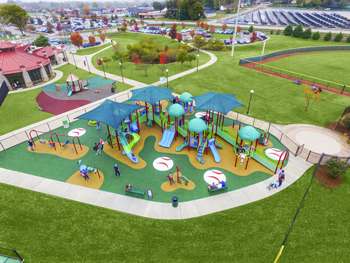
Themes in Action
Featuring a neighborhood theme, Friendship Park in West Covina, Calif., is a community destination that aims to draw people of all ages and abilities in for play and movement.
“Here children have the opportunity to imagine, role-play and learn how they can be part of a community,” Lisiecki said. “Spinning, rocking and game play add even more opportunities for children of all abilities to interact together and build friendships.”
A fitness circuit is part of the space, emphasizing the importance of fitness as part of a neighborhood, and encouraging families to get fit together outdoors, she added.
In West St. Paul, Minn., Thompson County Park radiates a creativity that invites kids into play, learning and discovery. The pollinator theme educates kids “on the importance of pollinators with themed play components and surfacing featuring honeybees, flowers and pathways for pollination,” Lisiecki said. A majestic tower overlooks the space, “beckoning children in for adventure and excitement and bringing replay value with new and different ways to climb. Bringing nature into the space, mature trees, planters and benches surround the play environment and provide the perfect complement to the clubhouse-style playground and outdoor theme.” RM



